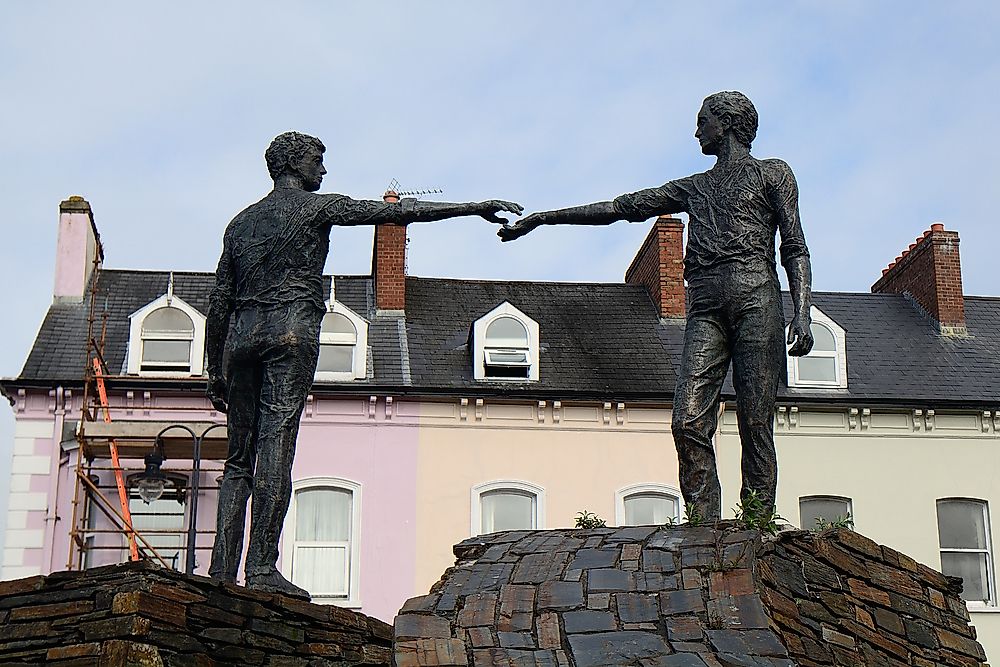What Was The Irish War of Independence?

The Irish War of Independence was a brief but violent war waged by various factions including the Irish Republican Army against British troops stationed in Ireland. The war began in 1919 and continued until a truce was called and a treaty signed in 1921. The Irish factions were fighting to end the more than 800 years of direct rule that had been imposed by Britain on Ireland. As a result, it was named the Irish War of Independence.
Background to the War
Since the 12th century, Ireland had been under direct English rule. Initially, the Crown used an absenteeism approach, where they did not try to assert full control of Ireland. However, after some rebellions, the crown imposed total control over Ireland, and King Henry VIII proclaimed himself King of Ireland. After this, there were several attempts by the Crown to assimilate (sometimes through force) the Irish people into the ways of the English people. Most of these attempts were met by various rebellions and military campaigns by the Irish against the English. However, Britain managed to maintain control over Ireland until the late 19th century, when Irish nationalist started pushing for self-governance. The Irish people were particularly outraged by Britain’s direct rule over them, as well as religious differences (the Irish were Catholics, while the English followed the Anglican religion).
Limited Self Governance
Around 1912, the British Parliament agreed with the Irish Party on the Home Rule, which gave the Irish people limited self-governance. However, this turned out to be more divisive. The Northern Ireland region, which was British-friendly, was opposed to the Home Rule, and this led to the rise of Ulster Volunteers, a militant group, rising to resist the British government from implementing the Home Rule. In response, the Irish nationalist created Irish Volunteers, a militant group that fought for the Home rule. When WWI broke out, different Irish factions came together to fight against the Germans. However, due to the war, the British government limited the autonomy offered to the Irish people. As a result, another radical Irish nationalist movement emerged the Irish Republican Army (IRA).
The Rise of the IRA
In 1916, the IRA invaded Dublin (Ireland's capital), and declared Ireland independent, in what was known as the Easter Rising. The British government responded with a military campaign and was able to quell the uprising. However, they meted extreme violence and cruelty that they ended up radicalizing the least radical Irish citizens. The situation became even worse when in 1918 the British government instituted a compulsory military service in Ireland to boost the number of its troops fighting in the WWI. On April 23, 1918, the Anti-Conscription Committee responded by coordinating a general strike, and this was followed by several anti-conscription protests and rallies. The turmoil around this time also saw the emergence of a radical Irish political party, the Sinn Fein, which won the 1918 elections and replaced the Irish Party in the British Parliament. Following their win, the party declared Ireland Independent, starting the events that would finally lead to the outbreak of the war.
The Course of the War
After declaring Independence, the Sin Fein created an independent parliament in Dublin, the Dail Eireann, and started forming a functioning Irish government. The IRA also shot dead two members of the Royal Irish Constabulary, which was friendly to the British government. These events officially sparked the Irish War of Independence. Initially, the British response was ineffective, as most of the British troops stationed in Ireland were mostly Irish, who had defected to the Independence movement. As such, the British relied on Black and Tans, retired British Army veterans who were recruited to provide support to the Royal Irish Constabulary. Since the retired veterans were more of mercenaries as opposed to regular British troops, the confrontations with the Irish movements were mostly brutal. The IRA also responded in kind, and it launched several guerrilla attacks on British forces and its installations. One of the most significant events during the war was on November 21, 1920, when an IRA hit squad assassinated 14 MI5 officers in Dublin. The RIC, mostly Black and Tans, responded by attempting to flush out suspected Irish Republicans at a Gaelic football game. However, they ended up firing into the crowd, killing 14 civilians and injuring dozens more. In response, several violent protests broke out, leading to the day being considered one of the most violent Bloody Sundays in Irish history.
The End of the War
In 1921 parliamentary elections, the Sin Fein party enjoyed another decisive victory, further increasing their power. In response, the British government responded by dissolving the Ireland Parliament, which resulted in more violent protests. The British government found itself unable to contain the war, and it finally called for a truce. After that, treaty negotiations started in London to end the war. On December 6, 1921, the Anglo-Irish Treaty was ratified, finally ending the war and creating the Irish Free State. The state was comprised of 26 out of 32 counties of the Island of Ireland. The remaining six counties, which were from Northern Ireland, opted out of the new state.











